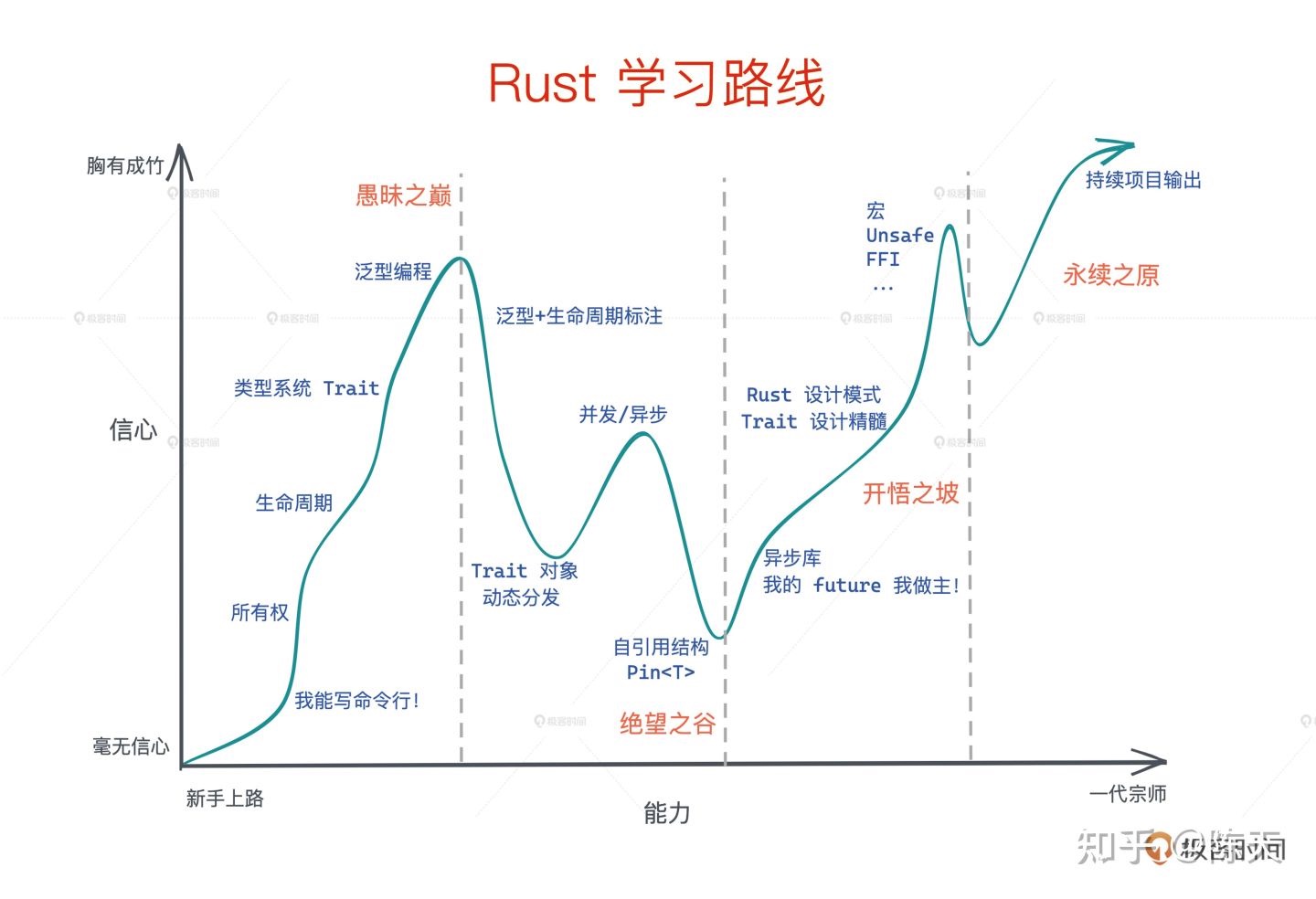Rust 学习笔记
https://doc.rust-lang.org/std/keyword.ref.html
https://www.bilibili.com/video/BV19b4y1o7Lt
https://tyrchen.github.io/rust-training/rust-training-all-in-one-cn.html

struct, enum
struct 仅仅用来定义一组数据,enum 枚举
struct Human {
name: String,
gender: Gender,
}
enum Gender {
Unknown = 0,
Female = 1,
Male = 2,
}
associated functions and methods
impl Human {
fn new() -> Self { Human{name: "hangj".into(), gender: Gender.Male, } }
fn test(_i: i32, _j: i32){}
}
这种就是 associated function,它的调用方式是 Human::new() Human::test(1, 2)
impl Human {
fn sleep(&self){}
fn eat(&mut self, _food: String){}
}
这种第一个参数是 &self 的函数就是 method,调用方式是通过 struct 的实例(instance) 去调用
fn main() {
let human = Human::new();
human.sleep();
}
也可以这样写 Human::sleep(&human) , 其实本质上,调用方式跟 associated function 并无区别, 只不过是语言层面提供的语法糖(syntax sugar)
&self 和 &mut self 也是个语法糖,其实就是 self: &Human 和 self: &mut Human
Human::sleep(&human) 这种写法这么麻烦,什么时候才有必要这么写呢?
当它需要显式调用某个 trait 的同名函数时。
trait 是啥
trait 就类似 C++ 中的纯虚函数,定义一组接口,是一种约定
trait Animal{
fn noise(&self)-> &'static str;
}
struct Sheep{}
struct Cow{}
struct Human{}
impl Animal for Sheep {
fn noise(&self) -> &'static str {"mieeeeeee"}
}
impl Animal for Cow {
fn noise(&self) -> &'static str {"mooooooo"}
}
impl Animal for Human {
fn noise(&self) -> &'static str {"66666"}
}
impl Human{
fn noise(&self)-> &'static str{
"hahahah"
}
}
fn main() {
let cow = Cow{};
let sheep = Sheep{};
let human = Human{};
println!("{}", cow.noise());
println!("{}", sheep.noise());
println!("{}", human.noise());
println!("{}", Human::noise(&human)); // 与 human.noise() 等效
println!("{}", Animal::noise(&human)); // 显式调用 Animal 的 noise
}
trait 参数
fn call_noise(ins: &impl Animal) {
println!("{}", ins.noise());
}
任何实现了 Animal 的 struct 的 instance 都可以作这个函数的参数
如果有多个 trait,则需要用 + 将 trait 连接起来
fn foo(v: impl Trait1 + Trait2){}
trait 作返回值
fn foo() -> impl Animal {
Human{}
}
generics 范型
struct Pos<T> {
x: T,
y: T,
}
fn get_type_name<T>(_v: &T) -> &'static str {
std::any::type_name::<T>()
}
fn main() {
println!("{}", get_type_name(&0));
println!("{}", get_type_name(&("hello".to_string())));
println!("{}", get_type_name(&Pos{x:1, y:2}));
}
trait + generic
上文中的 call_noise 可以定义如下
fn call_noise<T: Animal>(ins: &T){
println!("{}", ins.noise());
}
或者
fn call_noise<T>(ins: &T)
where T: Animal,
{
println!("{}", ins.noise());
}
如果有多个 trait,则需要将多个 trait 用 + 连接
struct P<T: Trait1 + Trait2>{ }
fn foo<T: Trait1 + Trait2>(){}
attributes
https://cloud.tencent.com/developer/article/1594094
https://doc.rust-lang.org/reference/attributes.html





【推荐】国内首个AI IDE,深度理解中文开发场景,立即下载体验Trae
【推荐】编程新体验,更懂你的AI,立即体验豆包MarsCode编程助手
【推荐】抖音旗下AI助手豆包,你的智能百科全书,全免费不限次数
【推荐】轻量又高性能的 SSH 工具 IShell:AI 加持,快人一步
· 分享一个免费、快速、无限量使用的满血 DeepSeek R1 模型,支持深度思考和联网搜索!
· 基于 Docker 搭建 FRP 内网穿透开源项目(很简单哒)
· ollama系列1:轻松3步本地部署deepseek,普通电脑可用
· 按钮权限的设计及实现
· Apache Tomcat RCE漏洞复现(CVE-2025-24813)
2015-05-21 ssh 登陆 端口转发